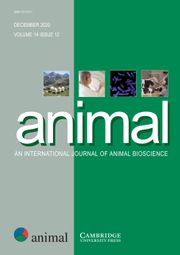Article contents
Effect of previous handling experiences on responses of dairy calves to routine husbandry procedures
Published online by Cambridge University Press: 06 December 2012
Abstract
The nature of human–animal interactions is an important factor contributing to animal welfare and productivity. Reducing stress during routine husbandry procedures is likely to improve animal welfare. We examined how the type of early handling of calves affected responses to two common husbandry procedures, ear-tagging and disbudding. Forty Holstein–Friesian calves (n = 20/treatment) were exposed to one of two handling treatments daily from 1 to 5 weeks of age: (1) positive (n = 20), involving gentle handling (soft voices, slow movements, patting), and (2) negative (n = 20), involving rough handling (rough voices, rapid movements, pushing). Heart rate (HR), respiration rate (RR) and behaviour (activity, tail flicking) were measured before and after ear-tagging and disbudding (2 days apart). Cortisol was measured at −20 (baseline), 20 and 40 min relative to disbudding time. There were no significant treatment differences in HR, RR or behaviour in response to either procedure. However, the following changes occurred across both treatment groups. HR increased after disbudding (by 14.7 ± 4.0 and 18.6 ± 3.8 bpm, positive and negative, respectively; mean ± s.e.m.) and ear-tagging (by 8.7 ± 3.1 and 10.3 ± 3.0 bpm, positive and negative, respectively). After disbudding, there was an increase in RR (by 8.2 ± 3.4 and 9.3 ± 3.4 breaths/min, positive and negative, respectively), overall activity (by 9.4 ± 1.2 and 9.9 ± 1.3 frequency/min, positive and negative, respectively) and tail flicking (by 13.2 ± 2.8 and 11.2 ± 3.0 frequency/min, positive and negative, respectively), and cortisol increased from baseline at 20 min post procedure (by 10.3 ± 1.1 and 12.3 ± 1.1 nmol/l positive and negative, respectively). Although we recorded significant changes in calf responses during ear-tagging and disbudding, the type of prior handling had no effect on responses. The effects of handling may have been overridden by the degree of pain and/or stress associated with the procedures. Further research is warranted to understand the welfare impact and interaction between previous handling and responses to husbandry procedures.
Information
- Type
- Behaviour, welfare and health
- Information
- Copyright
- Copyright © The Animal Consortium 2012
References
- 32
- Cited by

